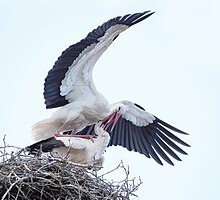White stork
The white stork (Ciconia ciconia) is a large bird in the stork family, Ciconiidae. Its plumage is mainly white, with black on the wings. Adults have long red legs and long pointed red beaks. They are on average 100–115 cm (39–45 in) from beak tip to end of tail, with a 155–215 cm (61–85 in) wingspan.
| White stork | |
|---|---|

| |
| Scientific classification | |
| Domain: | Eukaryota |
| Kingdom: | Animalia |
| Phylum: | Chordata |
| Class: | Aves |
| Order: | Ciconiiformes |
| Family: | Ciconiidae |
| Genus: | Ciconia |
| Species: | C. ciconia
|
| Binomial name | |
| Ciconia ciconia | |

| |
| Approximate ranges and routes
Breeding range Migration routes
| |
| Synonyms | |
| |
The stork breeds in Europe, northwestern Africa, and Asia (east to southern Kazakhstan) and southern Africa.
The white stork is a long-distance migrant. It winters in Sub-Saharan Africa to South Africa, or on the Indian subcontinent. When migrating between Europe and Africa, it avoids crossing the Mediterranean Sea and detours via the Levant in the east or the Strait of Gibraltar in the wes. The air thermals on which it depends for soaring do not form over water.
A carnivore, the white stork eats a wide range of animal prey, including insects, fish, amphibians, reptiles, small mammals and small birds. It takes most of its food from the ground, among low vegetation, and from shallow water.

Though monogamous, the birds do not pair for life. Pairs build a large stick nest, which may be used for several years. Each year the female may lay a clutch of four eggs, which hatch roughly 33–34 days after being laid. Both parents take turns incubating the eggs, and both feed the young. The young leave the nest 58–64 days after hatching, and are fed by the parents for another 7–20 days.
References
change- ↑ BirdLife International (2016). "Ciconia ciconia". IUCN Red List of Threatened Species. 2016: e.T22697691A86248677. Retrieved 19 May 2020.
